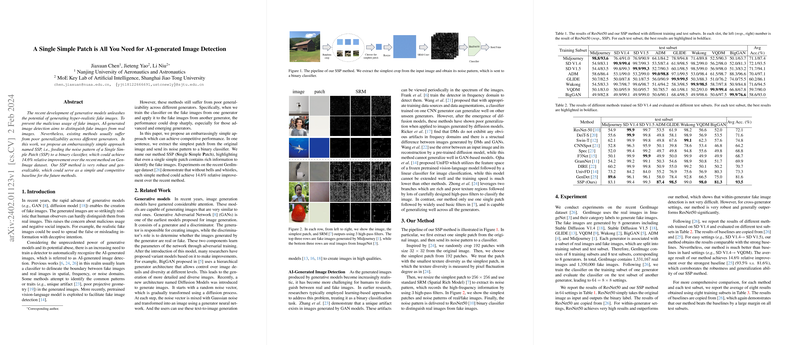Introduction
Detecting AI-generated images has drawn increasing interest, particularly given the sophistication of modern generative models like GANs and diffusion models, which craft images often indistinguishable from genuine photographs. The central challenge in this domain is the creation of detection methods that exhibit strong generalization across various generative approaches. Current strategies, such as those assessing artifacts or projective geometry in synthetic images, lack robustness when confronted with novel generative techniques or unseen models.
Related Work
Existing solutions in AI-generated image detection rely heavily on identifying patterns specific to the generation process of synthetic images. Approaches have ranged from training detectors to recognize distinct artifacts in frequency domains to exploiting complex architectures and rich model features. Despite these advancements, the fundamental issue remains the same—significant drops in performance when models trained on one type of generator are tested on another. The rapid evolution of generative models exacerbates this problem, making many existing techniques quickly outdated.
Our Method
Contrary to the prevailing trend of increasing complexity, the paper presents the Single Simple Patch (SSP) method. The essence of the proposed technique is deceptively straightforward: extract a basic patch from an image, capture its noise pattern using high-pass filters, and send this to a binary classifier for detection. The method disentangles itself from prior ones by ignoring the full image and focusing on a small, unassuming segment. This simplicity pays off, manifesting a 14.6% relative performance improvement over recent methods when tested on the GenImage dataset, which provides a wide range of generative sources for comprehensive evaluation.
Experiment
The efficacy of SSP is empirically validated on the GenImage dataset, encompassing over a million images produced by diverse generative models and real photographs from ImageNet. When assessed within the context of generative cross-compatibility, SSP's robustness shines. The proposed method doesn't merely hold its ground against a receptor-specific ResNet50 but surpasses it significantly in scenarios where training and test sets originate from disparate generators. The robustness extends through a variety of generative models, including those based on the latest diffusion technologies.
Conclusion
In sum, the SSP approach offers a refreshingly effective and uncomplicated strategy for discerning AI-generated images from authentic ones. Crucially, the approach's resilience across various generator types sets a new standard for this kind of detection task and paves the way for more adaptable and sustainably effective future methodologies. The results not only confirm the method's competitiveness within a dynamically evolving landscape of generative technology but also establish a baseline that future work will measure against. The ability to detect AI-generated images using such a simplified yet potent technique is a sharp turn from the anticipated trajectory and could shift the discourse towards simplicity in the arms race against perpetually improving synthetic image generators.
